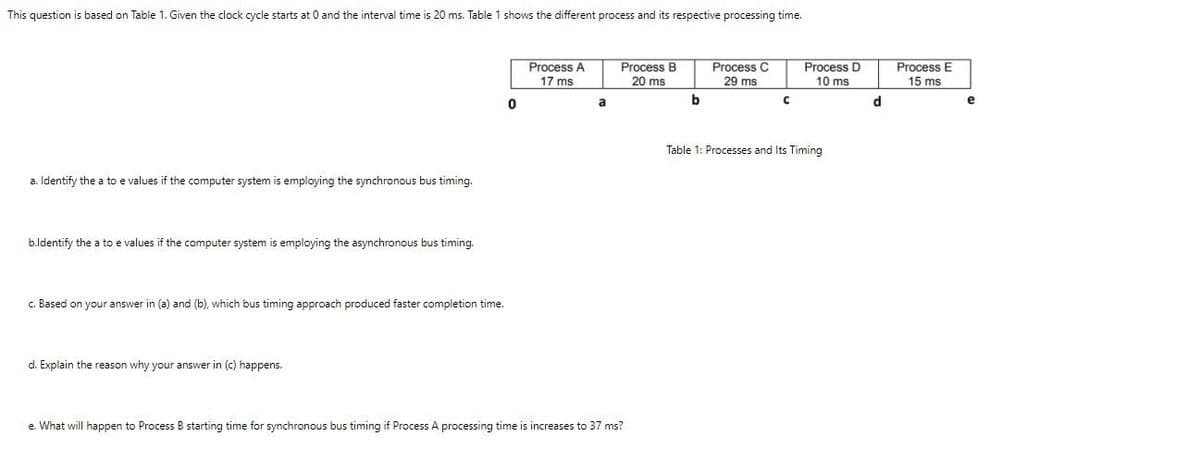his question is based on Table 1. Given the clock cycle starts at 0 and the interval time is 20 ms. Table 1 shows the different process and its respective processing time. Process A 17 ms Process B 20 ms Process C 29 ms Process D 10 ms Process E 15 ms a b d Table 1: Processes and Its Timing a. Identify the a to e values if the computer system is employing the synchronous bus timing. b.ldentify the a to e values if the computer system is employing the asynchronous bus timing. c. Based on your answer in (a) and (b), which bus timing approach produced faster completion time. d. Explain the reason why your answer in (c) happens. e What will hannen to Process R startingt Qus bus timing if Process A processing time is increases to 37 ms?
his question is based on Table 1. Given the clock cycle starts at 0 and the interval time is 20 ms. Table 1 shows the different process and its respective processing time. Process A 17 ms Process B 20 ms Process C 29 ms Process D 10 ms Process E 15 ms a b d Table 1: Processes and Its Timing a. Identify the a to e values if the computer system is employing the synchronous bus timing. b.ldentify the a to e values if the computer system is employing the asynchronous bus timing. c. Based on your answer in (a) and (b), which bus timing approach produced faster completion time. d. Explain the reason why your answer in (c) happens. e What will hannen to Process R startingt Qus bus timing if Process A processing time is increases to 37 ms?
Computer Networking: A Top-Down Approach (7th Edition)
7th Edition
ISBN:9780133594140
Author:James Kurose, Keith Ross
Publisher:James Kurose, Keith Ross
Chapter1: Computer Networks And The Internet
Section: Chapter Questions
Problem R1RQ: What is the difference between a host and an end system? List several different types of end...
Related questions
Question
COMPUTER ORGANIZATION AND ARCHITECTURE

Transcribed Image Text:This question is based on Table 1. Given the clock cycle starts at 0 and the interval time is 20 ms. Table 1 shows the different process and its respective processing time.
Process B
Process E
15 ms
Process A
Process C
29 ms
Process D
10 ms
17 ms
20 ms
b
d
e
Table 1: Processes and Its Timing
a. Identify the a to e values if the computer system is employing the synchronous bus timing.
b.ldentify the a to e values if the computer system is employing the asynchronous bus timing.
c. Based on your answer in (a) and (b), which bus timing approach produced faster completion time.
d. Explain the reason why your answer in (c) happens.
e. What will happen to Process B starting time for synchronous bus timing if Process A processing time is increases to 37 ms?
Expert Solution
This question has been solved!
Explore an expertly crafted, step-by-step solution for a thorough understanding of key concepts.
Step by step
Solved in 3 steps with 1 images

Recommended textbooks for you

Computer Networking: A Top-Down Approach (7th Edi…
Computer Engineering
ISBN:
9780133594140
Author:
James Kurose, Keith Ross
Publisher:
PEARSON

Computer Organization and Design MIPS Edition, Fi…
Computer Engineering
ISBN:
9780124077263
Author:
David A. Patterson, John L. Hennessy
Publisher:
Elsevier Science

Network+ Guide to Networks (MindTap Course List)
Computer Engineering
ISBN:
9781337569330
Author:
Jill West, Tamara Dean, Jean Andrews
Publisher:
Cengage Learning

Computer Networking: A Top-Down Approach (7th Edi…
Computer Engineering
ISBN:
9780133594140
Author:
James Kurose, Keith Ross
Publisher:
PEARSON

Computer Organization and Design MIPS Edition, Fi…
Computer Engineering
ISBN:
9780124077263
Author:
David A. Patterson, John L. Hennessy
Publisher:
Elsevier Science

Network+ Guide to Networks (MindTap Course List)
Computer Engineering
ISBN:
9781337569330
Author:
Jill West, Tamara Dean, Jean Andrews
Publisher:
Cengage Learning

Concepts of Database Management
Computer Engineering
ISBN:
9781337093422
Author:
Joy L. Starks, Philip J. Pratt, Mary Z. Last
Publisher:
Cengage Learning

Prelude to Programming
Computer Engineering
ISBN:
9780133750423
Author:
VENIT, Stewart
Publisher:
Pearson Education

Sc Business Data Communications and Networking, T…
Computer Engineering
ISBN:
9781119368830
Author:
FITZGERALD
Publisher:
WILEY